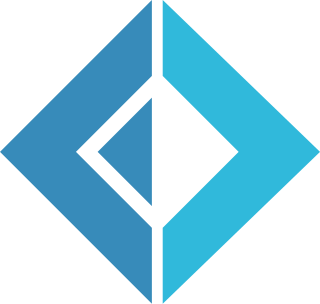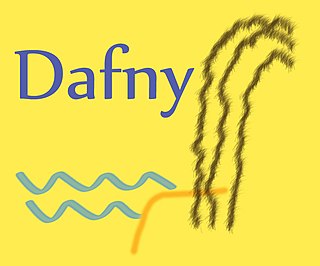Eiffel is an object-oriented programming language designed by Bertrand Meyer and Eiffel Software. Meyer conceived the language in 1985 with the goal of increasing the reliability of commercial software development; the first version becoming available in 1986. In 2005, Eiffel became an ISO-standardized language.

Design by contract (DbC), also known as contract programming, programming by contract and design-by-contract programming, is an approach for designing software.
Thread safety is a computer programming concept applicable to multi-threaded code. Thread-safe code only manipulates shared data structures in a manner that ensures that all threads behave properly and fulfill their design specifications without unintended interaction. There are various strategies for making thread-safe data structures.

In software engineering, the singleton pattern is a software design pattern that restricts the instantiation of a class to a singular instance. One of the well-known "Gang of Four" design patterns, which describe how to solve recurring problems in object-oriented software, the pattern is useful when exactly one object is needed to coordinate actions across a system.
A computer program or subroutine is called reentrant if multiple invocations can safely run concurrently on multiple processors, or if on a single-processor system its execution can be interrupted and a new execution of it can be safely started. The interruption could be caused by an internal action such as a jump or call, or by an external action such as an interrupt or signal, unlike recursion, where new invocations can only be caused by internal call.
Computer science is the study of the theoretical foundations of information and computation and their implementation and application in computer systems. One well known subject classification system for computer science is the ACM Computing Classification System devised by the Association for Computing Machinery.
A method in object-oriented programming (OOP) is a procedure associated with an object, and generally also a message. An object consists of state data and behavior; these compose an interface, which specifies how the object may be used. A method is a behavior of an object parametrized by a user.

F# is a functional-first, general-purpose, strongly typed, multi-paradigm programming language that encompasses functional, imperative, and object-oriented programming methods. It is most often used as a cross-platform Common Language Infrastructure (CLI) language on .NET, but can also generate JavaScript and graphics processing unit (GPU) code.
Object-oriented analysis and design (OOAD) is a technical approach for analyzing and designing an application, system, or business by applying object-oriented programming, as well as using visual modeling throughout the software development process to guide stakeholder communication and product quality.
In software engineering, the active record pattern is an architectural pattern. It is found in software that stores in-memory object data in relational databases. It was named by Martin Fowler in his 2003 book Patterns of Enterprise Application Architecture. The interface of an object conforming to this pattern would include functions such as Insert, Update, and Delete, plus properties that correspond more or less directly to the columns in the underlying database table.
The active object design pattern decouples method execution from method invocation for objects that each reside in their own thread of control. The goal is to introduce concurrency, by using asynchronous method invocation and a scheduler for handling requests.
Thread Level Speculation (TLS), also known as Speculative Multithreading, or Speculative Parallelization, is a technique to speculatively execute a section of computer code that is anticipated to be executed later in parallel with the normal execution on a separate independent thread. Such a speculative thread may need to make assumptions about the values of input variables. If these prove to be invalid, then the portions of the speculative thread that rely on these input variables will need to be discarded and squashed. If the assumptions are correct the program can complete in a shorter time provided the thread was able to be scheduled efficiently.
Domain-driven design (DDD) is a major software design approach, focusing on modeling software to match a domain according to input from that domain's experts.
Component Object Model (COM) is a binary-interface standard for software components introduced by Microsoft in 1993. It is used to enable inter-process communication object creation in a large range of programming languages. COM is the basis for several other Microsoft technologies and frameworks, including OLE, OLE Automation, Browser Helper Object, ActiveX, COM+, DCOM, the Windows shell, DirectX, UMDF and Windows Runtime. The essence of COM is a language-neutral way of implementing objects that can be used in environments different from the one in which they were created, even across machine boundaries. For well-authored components, COM allows reuse of objects with no knowledge of their internal implementation, as it forces component implementers to provide well-defined interfaces that are separated from the implementation. The different allocation semantics of languages are accommodated by making objects responsible for their own creation and destruction through reference-counting. Type conversion casting between different interfaces of an object is achieved through the QueryInterface method. The preferred method of "inheritance" within COM is the creation of sub-objects to which method "calls" are delegated.
In computing, subject-oriented programming is an object-oriented software paradigm in which the state (fields) and behavior (methods) of objects are not seen as intrinsic to the objects themselves, but are provided by various subjective perceptions ("subjects") of the objects. The term and concepts were first published in September 1993 in a conference paper which was later recognized as being one of the three most influential papers to be presented at the conference between 1986 and 1996. As illustrated in that paper, an analogy is made with the contrast between the philosophical views of Plato and Kant with respect to the characteristics of "real" objects, but applied to software ones. For example, while we may all perceive a tree as having a measurable height, weight, leaf-mass, etc., from the point of view of a bird, a tree may also have measures of relative value for food or nesting purposes, or from the point of view of a tax-assessor, it may have a certain taxable value in a given year. Neither the bird's nor the tax-assessor's additional state information need be seen as intrinsic to the tree, but are added by the perceptions of the bird and tax-assessor, and from Kant's analysis, the same may be true even of characteristics we think of as intrinsic.
Apache Empire-db is a Java library that provides a high level object-oriented API for accessing relational database management systems (RDBMS) through JDBC. Apache Empire-db is open source and provided under the Apache License 2.0 from the Apache Software Foundation.
Object-oriented programming (OOP) is a programming paradigm based on the concept of objects, which can contain data and code. The data is in the form of fields, and the code is in the form of procedures.
In information technology, Command Query Responsibility Segregation (CQRS) is a system architecture that extends the idea behind command–query separation to the level of services. Such a system will have separate interfaces to send queries and to send commands. As in CQS, fulfilling a query request will only retrieve data and will not modify the state of the system, while fulfilling a command request will modify the state of the system.

Dafny is an imperative and functional compiled language that compiles to other programming languages, such as C#, Java, JavaScript, Go and Python. It supports formal specification through preconditions, postconditions, loop invariants, loop variants, termination specifications and read/write framing specifications. The language combines ideas from the functional and imperative paradigms; it includes support for object-oriented programming. Features include generic classes, dynamic allocation, inductive datatypes and a variation of separation logic known as implicit dynamic frames for reasoning about side effects. Dafny was created by Rustan Leino at Microsoft Research after his previous work on developing ESC/Modula-3, ESC/Java, and Spec#.



